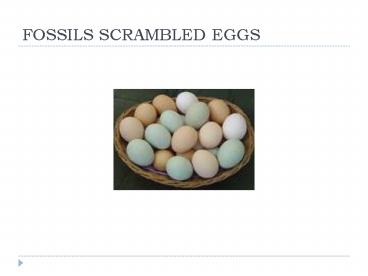FOSSILS SCRAMBLED EGGS - PowerPoint PPT Presentation
1 / 24
Title:
FOSSILS SCRAMBLED EGGS
Description:
FOSSILS SCRAMBLED EGGS 1. What is a fossil? 1. What is a fossil? Preserved remains of a once living organism. 2. What is a scientist who studies fossils called? – PowerPoint PPT presentation
Number of Views:177
Avg rating:3.0/5.0
Title: FOSSILS SCRAMBLED EGGS
1
FOSSILS SCRAMBLED EGGS
2
1. What is a fossil?
3
1. What is a fossil?
- Preserved remains of a once living organism.
4
2. What is a scientist who studies fossils
called?
5
2. What is a scientist who studies fossils
called?
- Paleontologist
6
3. How is a fossil formed?
7
3. How is a fossil formed?
- When living things are buried by sediments and
the sediments harden into rock and preserve the
shapes of the organisms.
8
4. Give 3 reasons why scientists study fossils.
9
4. Give 3 reasons why scientists study fossils.
- Provide evidence of how life has changed over
time. - Help scientists infer how Earths surface has
changed over time. - Clues to what past environments were like
- Climate has changed over time
10
5. What type of rock could you find a fossil in?
- Sedimentary
11
6. What does petrified mean? How does a
petrified fossil form?
12
6. What does petrified mean? How does a
petrified fossil form?
- Petrified means turning into stone.
- A petrified fossil forms as minerals replace all
or part of an organism.
13
7. What is the difference between a mold and
cast fossil?
14
7. What is the difference between a mold and
cast fossil?
- A mold is a hollow area in sediment in the shapre
of an organism or part of an organism. - A cast is a copy of the shape of an organism.
- MOLD CAST
15
8. What is a carbon film fossil?
- An extremely thin coating of carbon on rock left
when gases escape a buried organism
16
9. What is a trace fossil and give 2 examples.
17
9. What is a trace fossil and give 2 examples of
trace fossils.
- Evidence of the activities of ancient organisms.
- Ex fossilized footprint trails or burrows of
animals
18
10. Give 3 different ways an organism can leave
behind preserved remains with little or no change.
- Preserved in tar pits, amber, or by freezing
19
11. All the information that paleontologists
have gathered about past life is called
__________________.
20
11. All the information that paleontologists
have gathered about past life is called
__________________.
- The fossil record
21
12. Give 2 reasons why the fossil record is
important.
22
12. Give 2 reasons why the fossil record is
important.
- Provides evidence about the history of life
- Shows that organisms have changed over time
23
13. The fossil record show us that organisms
have changed over time. How?
24
13. The fossil record show us that organisms
have changed over time. How?
- The have gone from simple to more complex































